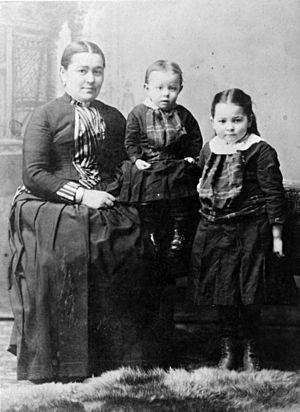Odille Morison facts for kids
Odille Morison (born July 17, 1855 – died 1933) was an important Canadian woman. She was a linguist, which means she studied languages. She also collected artifacts, which are old objects made by people. Odille was a community leader from the Tsimshian First Nation in northwestern British Columbia.
Early Life and Education
Odille Morison was born on July 17, 1855. Her birthplace was the Tsimshian village of Lax Kw'alaams. This village was also known as Fort Simpson or Port Simpson back then.
Her mother was Mary Quintal, a Tsimshian traditional healer and midwife. Her father was François Quintal, a French Canadian who worked for the Hudson's Bay Company (HBC). The Tsimshian people follow a matrilineal system. This means children belong to their mother's family group. So, Odille was part of the Gitlaan tribe. She was likely from the Killerwhale crest.
Odille grew up speaking three languages. She knew English, Tsimshian, and French. She also learned Chinook Jargon, a trade language. In 1862, a missionary named William Duncan (missionary) moved some people to a new Christian community. This community was called Metlakatla, British Columbia. Odille and her family moved there with him. She went to school at the mission in Metlakatla.
In August 1872, Odille was seventeen years old. She married Charles F. Morison. Charles was an Englishman and worked as a clerk for the Hudson's Bay Company. They were married by a ship's chaplain. The local missionary refused to marry them for reasons that are not known. The Morisons also had a home in Port Essington, British Columbia. This was a town where fish were canned. The founder of the town was Robert Cunningham. He was Odille's mother's brother-in-law.
Important Contributions
Odille Morison played a key role in a disagreement. This was between missionary William Duncan and his bishop, William Ridley (bishop). Odille helped by translating parts of the New Testament and a prayer book. She translated them into the Tsimshian language, called Sm'algyax. Duncan did not want her to do this.
Her translation work was very important. It helped create the first practical way to write the Tsimshian language. This writing system is known as the "Ridley orthography." Odille chose to support Bishop Ridley in this disagreement. This led her to stay in "Old" Metlakatla. In 1887, Duncan started a new community. He moved 800 Tsimshian settlers to "New" Metlakatla, Alaska. Odille stayed behind because she was very dedicated to her large Tsimshian family. Her family also chose to remain in Old Metlakatla.
In 1888, Odille met Franz Boas. He was an anthropologist, a person who studies human cultures. They met when Boas visited Port Essington. Boas helped Odille publish an article. This article was about Tsimshian proverbs. It appeared in the Journal of American Folk-Lore in 1889.
Over the next few years, Odille collected many items for Boas. She gathered over 140 artifacts. These items were shown at the 1893 Columbian Exposition in Chicago. The collection included two totem poles. She also sent Boas information about Tsimshian culture.
Later Life
Both Odille Morison and her husband Charles died in 1933. They passed away in Metlakatla, British Columbia.



